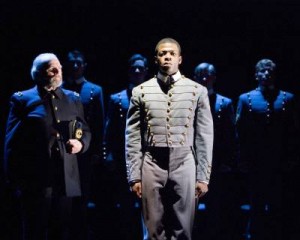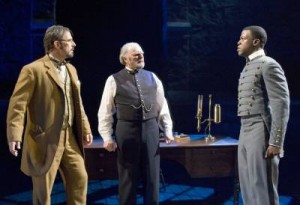
Near the beginning of Michael J. Chepiga’s Matter of Honor, the audience at
the Pasadena Playhouse is plunged into darkness. We hear a loud noise, like a
powerful echoing drumbeat, then a series of cries. A beating is taking place. We
know from that moment that we are in for a theatrical experience very much
out of ordinary.
Chepiga’s provocative world premiere drama, thrillingly staged by Scott
Schwartz, is a worthy successor to two previous Pasadena Playhouse
productions. Like John Patrick Shanley’s Doubt, and his Defiance, Matter of
Honor deals with secrets and lies, hidden behind the veil of a hierarchy, in this
case the granite walls guarding West Point Military Academy, a society and a
culture unto itself.
Chase (Eric Lutes), a private detective with a serious drinking problem, is being
questioned by Stern (Adam J. Smith), a military officer about a court-martial
currently under appeal, “the biggest scandal since Lincoln and Booth.” We learn
that Johnson Whittaker (Cedric Sanders), the second African American ever
admitted into West Point, was beaten by unknown assailants, his ears cut “as a
farmer marks livestock,” and that the court-martial being appealed is his.
The mystery of how Whittaker came to be beaten, and by whom, and how the
military dealt with this crime is at the heart of Matter of Honor.
Also at the heart of the story are three very different men. Investigator Chase is
the antithesis of a military man. Officer Schofield (Richard Doyle), the head of
West Point, is the military personified. And Cadet Whittaker is the outsider,
desperate to be an officer but shunned by his fellow cadets from the moment of
his arrival at the Academy. Just how difficult his life has been we soon discover.
Whittaker has been subjected to “silencing,” which means that no cadet will
have any social intercourse with him, simply because he is not white. He says at
one point in the play that he has not gone a day without having been spat
upon. “There is very little that happens to me that is not because of the color of
my skin, except the weather,” he says. But he is no patsy. In his scenes with
Chase and Schofield, he knows how to fight back with sarcasm, his only
weapon. This is a man who knows in his heart that he is every bit their equal.
As the play progresses, Chase begins to discover the truth about what
happened the night of the beating, or is it the truth? He, and the audience,
begin to have doubts. As in Shanley’s Doubt, just as we begin to believe one
thing, we start to wonder if perhaps the truth is quite different from what we’d
come to believe.
Matter of Truth triumphs on several levels. First of all, it is a history lesson. Many if
not most Americans are unaware that, just five years after the Civil War, the first
African American was accepted into West Point. The play is also a fascinating
glimpse into the world of West Point, where “honor” is valued above everything
else, yet where cruel traditions like “silencing” were allowed until the 1970s.
Most of all, it is a thrilling theatrical experience. Schwartz’s direction is nothing
short of inspired. This Pasadena Playhouse production exemplifies how an gifted
director can make a play so much more than just the written word it began as.
When we flash back to the beating, the imposing gates of the West Point
backdrop open suddenly, the stage is filled with smoke and red light, drumbeat
accented music pulsates in the background, as we see the attack in dramatic
silhouette. A second flashback revisits the beating, but the light this time is
white, and what we see enacted is quite different. There’s also a scene later in
the play where different handwritings are being compared (a key to solving the
mystery) and as Chase examines the evidence before him, we see the
handwritings projected behind him, involving us in the crime solving process.
The technical team behind the production is at the same level of talent as
Schwartz’s direction: Maggie Morgan’s period perfect West Point uniforms,
Donald Holder’s striking lighting (especially effective in scene changes), Robert
Brill’s imposing West Point set which dwarfs the actors standing in front of it, and
above all Mark Bennett’s magnificent sound design and original music, which up
the ante in every scene.
Performances are first rate, especially those of Lutes, Sanders, and Steve
Coombs. Lutes as investigator Chase (a far cry from his TV role on Caroline in the
City) creates a fascinating, complex and troubled character, with his own secret
to bury under an alcoholic haze. Sanders too reveals layer upon layer of
complexity. His Whittaker is a man far too intelligent and aware of his self-worth
for the era he was born into. Coombs, who made a memorable debut in A
Picture of Dorian Gray, likewise takes a role which could have been a stereotype
(the handsome blond Southern officer and gentleman) and imbues him with
complexity. Our aversion to for this man turns grudgingly into a kind of liking
thanks to Coombs, a real star on the rise.
Doyle does fine work as a military officer trying to do his best in his job, but
hampered by the time in which he lived. Brian Watkins is excellent in a trio of
roles: a Minnesota cadet who made the mistake of being a nice guy by daring
once to talk to Whittaker, one of the court-martial lawyers, and (very skillfully
indeed) the drummer whose military drumbeats effectively punctuate scene
changes. Steve Holm, John O’Brien, and Ryan J. Hill portray cadets. Practically
speaking, they are there to move the furniture, but artistically, their onstage
military movements are choreographed and executed with such military
precision that they are far more than just glorified stagehands.
Like Doubt and Defiance, Matter of Honor runs 90 minutes without an
intermission. Like those two plays, it has a beautifully written script meant to
provoke discussion (“Was he or wasn’t he?” “Did he or didn’t he?”). And under
Scott Schwartz’s inspired direction, it is an absolutely thrilling experience that
kept me on the edge of my seat until the final curtain.
Pasadena Playhouse, 39 S. El Molino Ave., Pasadena.
–Steven Stanley
September 5, 2007
Photos: Craig Schwartz




 Since 2007, Steven Stanley's StageSceneLA.com has spotlighted the best in Southern California theater via reviews, interviews, and its annual StageSceneLA Scenies.
Since 2007, Steven Stanley's StageSceneLA.com has spotlighted the best in Southern California theater via reviews, interviews, and its annual StageSceneLA Scenies.







 COPYRIGHT 2024 STEVEN STANLEY :: DESIGN BY
COPYRIGHT 2024 STEVEN STANLEY :: DESIGN BY